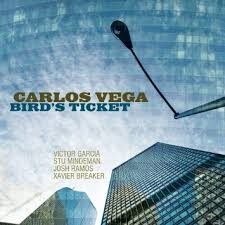
It was this that brought about Bird’s Ticket (Origin 82708) and a collaboration with some of Chicago’s first-call players. With Vega are Victor Garcia (trumpet), Stu Mindeman (piano, Rhodes), Josh Ramos (acoustic bass) and Xavier Breaker (drums). All of the compositions or Vega originals and this is just the band to make them come alive.
The album opens with A Confluence in Chi-Town and what a start. The confluence of these musicians as well as the coming-together of such variant styles is a treat. It starts off with a Baroque-ish counterpoint between the horns which leads into Montuno rhythms from the piano. Brandenburg meets Havana.
So many things to hear in this, the first piece of the album. Ramos’ bass and Breaker’s drums are a treat all their own but Mindeman’s piano with them is something mesmerizing. The solos of Garcia and Vega spring full-bodied from the foundation established by piano, bass and drums. Right from the first, Vega establishes his mastery of the instrument and the music he creates. He is in complete control and Garcia is the perfect partner. The rhythm section takes over the run to the end with the horns adding hot punctuation. The end comes like the slamming shut of the door to a treasure room. Open it back up!
The title track, Bird’s Ticket, comes next breathing fire and fanning the flames. Incredibly enjoyable in its straight-ahead Jazz approach and its attack of melodic and rhythmic punches. Seriously, everyone grabs the attention of the listener which creates a completely infectious riot of fun. Vega’s solo knocks you down and Ramos and Breaker kick you while you’re down there. All with grins on their faces, to be sure. The unified trumpet and sax lift you back up, dust you off, and slap you on the back. Mucho gusto!
Taurus on the Run begins with a Ramos solo that is soon joined by Mindeman on the Rhodes. The quiet horns introduce the fine melody and the solos break in complementary directions. The Garcia trumpet carries the tune high up as the rhythm section carries on solidly. Mindeman’s solo on the Rhodes is a cool touch with his extended improv on the theme. The Vega sax solo takes on a vibrant tone with a swaying intensity. The horns mirror each other to the end.
Taurus and Virgo opens with a sweet piano solo that takes flight quickly and is accompanied by the drums then bass in a hot rhythmic festival. All the more as Juan Pastor makes his only appearance on the cajon. Mindeman sold himself on this one. Vega and Garcia enter together and the Latin Jazz heats right up. Garcia solos brilliantly while that rhythm section keeps you on the floor. Vega’s sax is fluid and vibrant. All intoxicating and that rhythm section and the percussive playing of the horns are just incredible. Wow.
A smoother turn takes place on Dragon Rose. The horns are together over the rhythm section and the quick exchange between sax and trumpet sets up a longer dialogue between them. Garcia is beautifully lyrical and is answered by an equally lyrical rejoinder from Vega. The Rhodes provides accents that highlight the soloists but pay attention to the solo Mindeman offers. Melodic, yes, and often percussive. Cool flow between them all.
And then things really heat up with Chicago Eight. It is a nearly-visual imagery that erupts from the horns, hammers, strings and sticks in recalling the riot, arrests and eventual trials of the so-called Chicago Eight (after Bobby Seale was removed from the trial) during the 1968 Democratic National Convention. The pressure, the anger, the clashes are all present. The talkative piano, the marching of the bass, the pounding of the sticks, all bring to mind the protests of the demonstrators, the march of the police and the swinging nightsticks in “crypto-fascist” fashion, as Gore Vidal described it. Very emotional and very sensory. And unrelenting.
That is alleviated by the delectable runs and tones of Elements. Vega’s sax tone and fluidity are finely expressed. Garcia answers with subtle touches and splendid runs that can only be described as lush. Mindeman’s Rhodes has a say in the matter and it speaks volumes. Ramos and Breaker provide mesmerizing support beneath. Cool chords and great rhythms make this an outstanding piece.
The Wizard wastes no time in coming straight at you. Dazzling and effervescent, the horns and piano cast their distinctive spells. Mindeman presents a swirling solo and creates his own hypnotic effect as he opens the way for Garcia’s solo. The bass and drums with the punchy piano create solid platform for Garcia, who does the baton-pass to Vega who keeps the set pace and builds upon all that has gone before. This is improvisation at its hottest. Ramos does not ease up in his bass solo and does his own brilliant pass to Breaker for a drum solo. The transitions between solos from all of these artists are fascinating. The closing moments are tight and extremely enjoyable. A cool end.
In Other Words comes across as a finely cooperative big band arrangement in its beginning. The Jazz piano is as Chicago-sounding as you hope to hear. Vega takes up the theme and the drive with hot effect. Garcia fades in as Vega fades out, another exemplary transition. Ramos works a beautiful bass line beneath the solos. His own solo is spot-on and his strummed passage is matched by the piano. Dug that. The horns return to carry the melody away. Garcia’s sustained note fades out the piece.
The album ends with Reflecting Pools. The shimmering imagery of the horns is exquisite. The Rhodes is the right sound with its own watery tones. The susurrus of the brushes and the cymbal splashes add to the overall impression to what can be described as a work of Jazz Impressionism. The trumpet and sax offer some of their warmest work of the album. It may be the loveliest track of the whole album and a sweet way to bring everything to a close.
Carlos Vega has created a multifaceted experience of joined influences and styles on Bird’s Ticket. His compositions are distinctive and intense in their virtuosity and their spacious room for improvisation. The artists are more than equal to the task set before them which creates a feeling of enjoyment for the players and the audience. Chicago should give Carlos Vega a parade down Lakeshore Drive.
~Travis Rogers, Jr. is The Jazz Owl
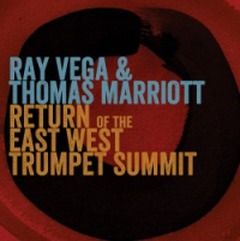
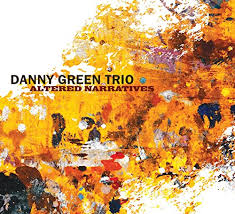
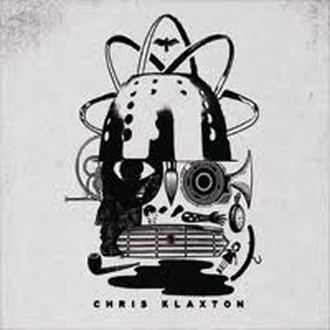
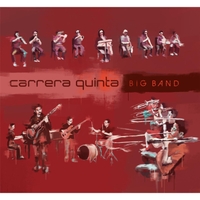
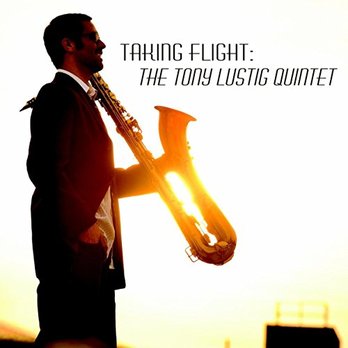

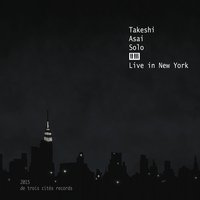
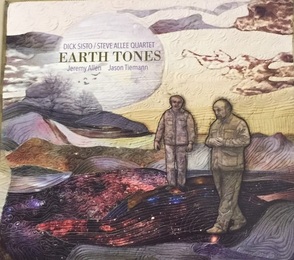
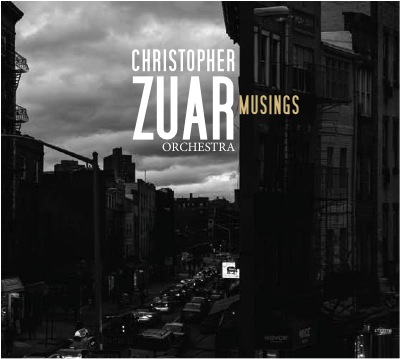
 RSS Feed
RSS Feed
